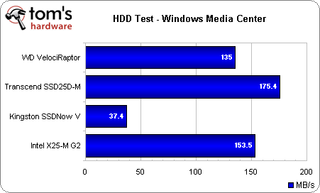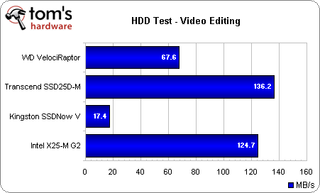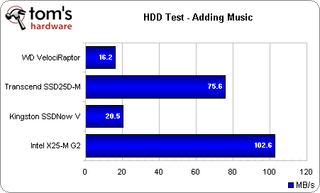Can Bargain SSDs Give Windows A Quantum Performance Leap?
Benchmark Results: PCMark Vantage, Continued
According to Futuremark, maker of the PCMark Vantage benchmarks, this video editing test involves performing video read and skip functions along with concurrent video writes. The read/write load is about 53% and 47%, respectively. You’d expect access times to impact performance here, but the VelociRaptor simply eats the SSDNow as an appetizer while Intel and Transcend race on above 120 MB/sec.


The story looks similar in Windows Media Center, which hits an almost even 50/50 split between reads and writes. Specifically, the test analyzes SDTV video playback, SDTV video streaming to a WMC extender, and SDTV video recording. I would expect this test to be especially telling given how many users are increasingly using systems as HD content hubs.
Interestingly, the VelociRaptor puts in what may be its best showing of the roundup in this test, drawing close enough to the top SSDs to make it the overall value winner for this application. Once again, Kingston takes a pile driver, putting a final nail in the idea that entry-level SSDs might be OK for write-intensive apps. Transcend emerges the winner in both of these tests, but I’ll dredge up that caveat about Intel performance results in this suite. With its TRIM support, Intel should have won.


Adding music into Windows Media Player 11 is about 80% read-based. No surprises at the high-end, but the WD and Kingston drives are separated by only about 20% at the other extreme. At 16 or 20 MB/s, I can see how adding a large music collection might chew up a lot of system bandwidth for an extended time. This isn’t an operation most uses will do often, but it’s still important for those with media-centric systems.
On application loading, the test is about 87% read-based. Futuremark states that the test involves loading Word 2007, Photoshop CS2, Outlook 2007, and an IE7 browser. Kingston shows a 3x lead over WD here as reads become more prominent. The surprise is Intel’s sudden doubling of Transcend’s performance, delivering a number that’s over 12x faster than the fastest hard drive on the consumer market.
Now, four apps is a fair load, but we’re still talking about a synthetic environment. It’s time to keep things real.
Stay on the Cutting Edge
Join the experts who read Tom's Hardware for the inside track on enthusiast PC tech news — and have for over 25 years. We'll send breaking news and in-depth reviews of CPUs, GPUs, AI, maker hardware and more straight to your inbox.
Current page: Benchmark Results: PCMark Vantage, Continued
Prev Page Benchmark Results: PCMark Vantage Next Page Really Simple-
timbo Dual drive ftw. It especially gives me an important advantage in loading mp maps faster: every second counts in getting to advantageous spots first; it can & does change the outcome of who wins.Reply -
I love how they neglect to include Linux, Unix and Mac. I guess that makes us just less important. By the way I'm pretty sure a SSD would make Ubuntu pretty snappy as well.Reply
-
zebow2002 Linux, Unix and Mac have a combined market share of 30%, wich makes them less important. Great article, can't wait for my Intel G2.Reply -
johnbilicki Two 64GB SSD's in RAID0 is more then enough for most users when a second RAID or bare drive is presumed. The main issue is still the cost per GB at $2-2.5 a GB I'm not knocking any one over even if it halves my boot and application time.Reply
Also in general please stop making socket 1156 like it's the best thing in town because Intel has made it clear that it's a mainstream socket and they will not be getting more then four cores ever; I am only saying this since as an upgrader I hate to see other people presume socket 1156 has a good upgrade path which it doesn't unless Intel changes it's mind and the last time I checked the upgrader's best friend is AMD (good motherboards/chipsets for under $400, unlocked multipliers for under a grand, unlocked cores, etc). -
xrodney I am using now 128GB patriot torx SSD as boot drive (only OS and few apps there leaving half drive not used) and rest apps and media having on 1.5TB 7200rpm drive.Reply
I was really thinking for 3-4 months before jumping on SSD but glad I did. Just 13 min to fully install W7, 15-18 seconds to desktop, 5-8 seconds to shutdown (5 no app running, 8 with loads of them started) and apps starting 3-8 times faster then with regular hdd.
Same as author 1st time booting to OS on SSD almost fell of chair as I was expecting to be it faster but not that much (3.5min boot time before) -
haplo602 wow ... I ma living on an ancient 40GB PATA drive at home. windows and linux and data. I really do not get how your boot drive can be 200GB of application only.Reply
a nice 64GB SSD drive would be just fine for all my needs.
one remark, can you include fakeraid (mobo implemented raid) raid1 configuration tests ? -
xrodney haplo602wow ... I ma living on an ancient 40GB PATA drive at home. windows and linux and data. I really do not get how your boot drive can be 200GB of application only.a nice 64GB SSD drive would be just fine for all my needs.one remark, can you include fakeraid (mobo implemented raid) raid1 configuration tests ?Its not that hard windows 7 64bit alone take like 15GB add hybernation file few apps and you are way over 40GB, some apps or games can have even more then 10GB (AoC have 30GB+).Reply -
Otus Looks like I might need to get a small SSD soon. Since my Ubuntu root (OS+apps) partition has just 4GB of data, I should be more than OK with a 64GB drive. Unfortunately stuffing Windows in there would be almost impossible.Reply -
xrodney SnarkI get the boot drive on desktop angle... but what about laptop installations?On laptop you should even see more performance boost as 2.5" drives they use are usually considerably slower then on desktop. Also you would get rid of possibility damaging disk when dropping your notebook as SSDs have no moving parts.Reply
Most Popular

